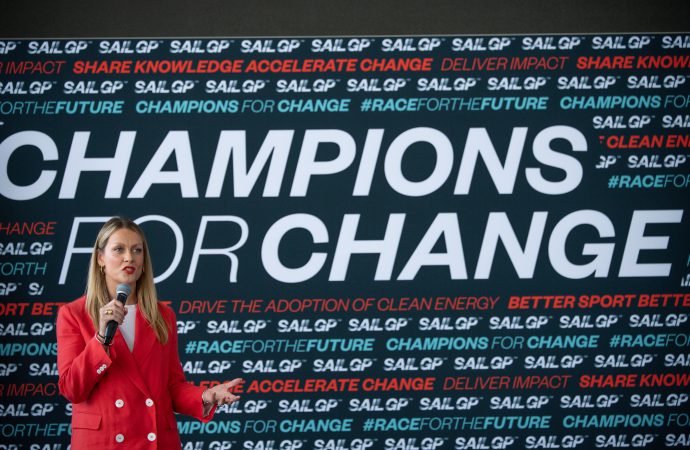Fiona Morgan, SailGP’s director of purpose and impact, explains how the league is addressing sport’s most difficult environmental challenge through supplier engagement and the Impact League
Sport needs to get real about Scope 3 emissions if we want to be credible on climate, says Fiona Morgan as we chat in the canteen of SailGP’s head office in London. A week on from our interview, the league’s director of purpose and impact will tell a room packed with sports industry professionals that instead of “hiding” from Scope 3, SailGP has “leaned into it” – and others should follow suit.
SailGP’s first Purpose & Impact Report for its second season (full disclosure, The Sustainability Report’s parent company, Touchline, helped to produce the report) demonstrates that 99% of its 47,490 tCO2e impact comes from indirect sources, including supply chain and fan travel.
That’s quite a representative proportion across sport where, on average, around 80-90% of emissions are Scope 3. It paints a daunting picture for a couple of reasons: the sheer size of that number and the fact that those emissions are out of the direct control of the organisation adds an extra layer of complexity and makes it easy to ignore.
But inaction is not an option, says Morgan, adding that the supply chain, which accounted for 34% of SailGP’s season two emissions, is a key area of focus. After challenging Kuehne+Nagel to align with its own climate ambitions, the logistics company offered SailGP a “carbon neutral service” with emission reduction targets built into their contract. Through its SeaExplorer platform, it also helps SailGP map out the most sustainable route to ship boats and equipment to race locations.
“They can’t control how many events or how many boats we have, but they’re invested to reduce that footprint,” she says. “It’s a collaboration of shared values. They feel like an extension of SailGP, but that’s a big alignment.
“We need partners to lean in and help us be more sustainable. We need them to think about how they can reduce their footprint and take more responsibility. If every supplier gave us a carbon neutral service, that would be incredible.”
The parameters are clear. Merchandise suppliers are expected to have carbon emission measurement and reduction plans, manufacture and source locally, as well as use 100% recycled material or organic cotton. A food charter encourages low-carbon choices that are locally-sourced, mainly plant based and with minimal packaging.
Its SailGP’s Impact League, however, that presents further opportunities for partners and suppliers to help the competition reduce its environmental impact.
The inaugural Impact League, in which teams can win points (and ultimately a trophy) for their positive impact work off the water, was won by the New Zealand SailGP team, which secured $100,000 for its Race for the Future partner Live Ocean to go towards funding research into kelp forests to explore their potential to sequester carbon emissions.
As more teams have joined so have more Race for the Future partners. The Canadian SailGP team has linked up with Ocean Wise on an outreach and education programme focused on ocean restoration, while the newly-established Swiss team is supporting VI Foundation to improve the quality of life for disabled people.
When it was launched during SailGP’s Plymouth race last year, the Impact League presented perhaps sport’s first real meaningful attempt at connecting sustainability and purpose to the core product – what happens on the field of play. Morgan acknowledges that, in the beginning, it was tricky to fully engage the athletes with the concept as their performance on the water was the first priority. But, over time, their competitive nature has made it almost as hotly contested as what happens on the water.
Teams compete across 10 criteria (sustainability strategy; tech and innovation; clean energy; merchandise; waste and single-use plastic; travel and accommodation; food; using your voice; diversity, equality and inclusion; and collaboration).
Highlights from the first edition include the Spanish team implementing a carbon reduction plan for its merchandise, the French team trialling hydrogen-powered generators to reduce emissions, the Japanese team reducing single-use plastic by 60% and the Danish team generating 10 million views for its ‘Beneath the Surface’ video.
And while those core criteria will remain the same, Morgan stresses that the league has “evolved” and will continue to.
“We wanted to listen to the teams as they’re the ones doing it,” she explains. “We’ll never change our strategic pillars, but we have changed how we score things. Teams have said they want more points for innovation because that’s where they think the real positive impact is. We have to support that because they’re professional athletes and if they spend time slightly away from the sport, they want to use it in a way that fundamentally shifts the dial.”
Measuring innovation can be quite a subjective thing. Does it mean new tech, a new way of thinking, or both? Either way, innovation is not something that can be measured from race to race, so teams have been set the challenge to focus on three major projects over the course of the season and progressively work on them as time goes on. The Great Britain team integrated solar panels on its rib, for example, which is now likely to be rolled out across all teams.
To support gender equality through the Women’s Pathway Program, which fast-tracks talented female sailors into the sport, teams are exploring ways to adapt the boats’ grinder technology to make them more accessible for women.
One of the rules that has come into force for season three of SailGP is that teams involved in a collision during a race will lose Impact League points because there is a material waste and carbon cost associated with those incidents.
“Sustainability needs to be less siloed and thought of more as a business function or part of your strategy,” Morgan says. “The person in charge of sustainability needs to be on the senior leadership team. It needs to be a consideration across everything and you have to embed it in your operations by incentivising people.”
Opt into our weekly newsletter for exclusive content focused on sustainability strategy, communication and leadership for sport’s ecosystem.










Leave a Comment
Your email address will not be published. Required fields are marked with *